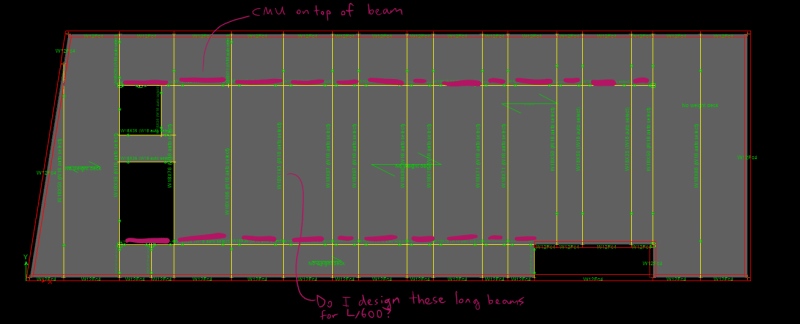milkshakelake
Structural
What's the deflection limit of a steel beam supporting reinforced masonry? I use L/600, but my beams are getting too massive, so I'm wondering if L/240 is appropriate.
ACI 530-13 5.2.1.4.1 uses L/600 for unfactored dead plus live loads. However, the commentary has something interesting.
The commentary says that the limit "might" apply to reinforced masonry that has vertical reinforcement only. All my reinforced masonry walls have ladder trusses at 16" on center vertically, which might count as horizontal reinforcement. All this reinforcement gives the masonry some crack control and ductility. Is that enough of an argument to definitively allow L/240?
Bonus question: Separately from the previous question, let's say I have to use L/600, like if it was theoretically unreinforced masonry. Would the deflection limit apply to the long beams in the picture below? The distance between them is about 6' average. My thinking is that it does apply to long beams. Although I usually consider local deflection of the beam directly under the masonry, in this case they're pretty rigid and most of the deflection would come from the long beams. On the other hand, they'd all deflect pretty much the same amount (they're all controlled by deflection), so I don't see a lot of potential for differential deflection.

I did see an old thread about this, but it's maybe referring to some outdated code commentary:
ACI 530-13 5.2.1.4.1 uses L/600 for unfactored dead plus live loads. However, the commentary has something interesting.
5.2.1.4.1. The deflection limits apply to beams and lintels of all materials that support unreinforced masonry. The deflection requirements may also be applicable to supported reinforced masonry that has vertical reinforcement only.
The commentary says that the limit "might" apply to reinforced masonry that has vertical reinforcement only. All my reinforced masonry walls have ladder trusses at 16" on center vertically, which might count as horizontal reinforcement. All this reinforcement gives the masonry some crack control and ductility. Is that enough of an argument to definitively allow L/240?
Bonus question: Separately from the previous question, let's say I have to use L/600, like if it was theoretically unreinforced masonry. Would the deflection limit apply to the long beams in the picture below? The distance between them is about 6' average. My thinking is that it does apply to long beams. Although I usually consider local deflection of the beam directly under the masonry, in this case they're pretty rigid and most of the deflection would come from the long beams. On the other hand, they'd all deflect pretty much the same amount (they're all controlled by deflection), so I don't see a lot of potential for differential deflection.

I did see an old thread about this, but it's maybe referring to some outdated code commentary:
